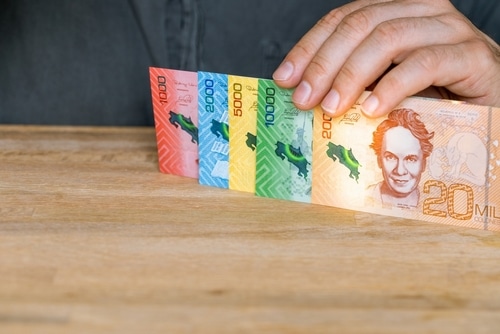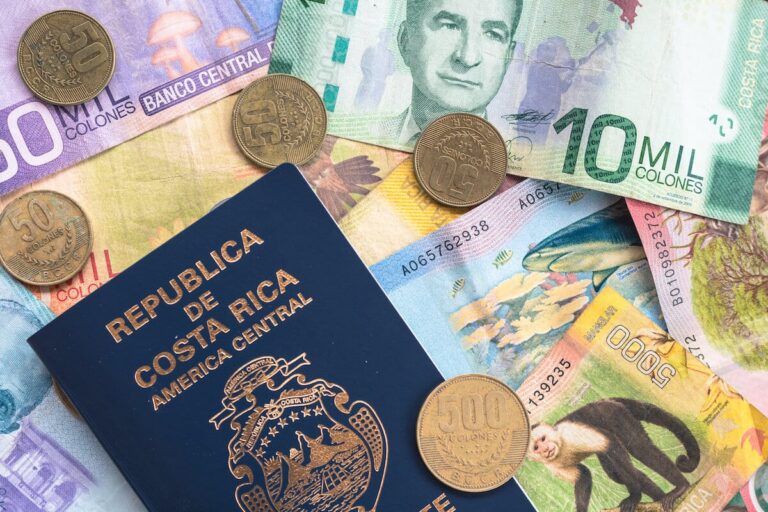Whether you want to visit Costa Rica for the rainforests, beaches, or its friendly people, it is good to know about the country’s money—the colón (CRC). This can help you get by in daily life and with money matters there. The colón is given out by the Central Bank of Costa Rica (Banco Central de Costa Rica). This money shows the country’s pride, its natural side, and its past.
The Basics of the Costa Rican Colón
- Currency Code: CRC
- Symbol: ₡ (a C with two lines going up and down)
- Subunits: 100 centimos (though people do not use them much today)
- Banknotes: 1,000; 2,000; 5,000; 10,000; 20,000; 50,000 colónes
- Coins: 5, 10, 25, 50, 100, and 500 colónes
Banknotes are made in different sizes. This helps people, including those who cannot see well, to use them more easily.
A Brief History of the Costa Rican Colón
Costa Rica started using the peso as its money in 1839. The colón took the place of the peso in 1896. It was named after Christopher Columbus, who is called Cristóbal Colón in Spanish. Over the years, the country’s money system has changed. In the past, private banks made the notes. In 1950, the Central Bank took over the job of making the country’s money.
Understanding the Colón’s Exchange Rate
The colón had a crawling peg for many years. This made the colón slowly lose value against the U.S. dollar. In 2006, Costa Rica started to use a currency band. This let the colón move up and down within a set range connected to the dollar.
Today, the price depends on how much people want to buy and sell, but the Central Bank steps in to keep things steady. Most visitors will see that U.S. dollars are used a lot, mainly in busy places. Still, you will need some local colónes for small things.

5 Fascinating Facts About the Costa Rican Colón
1. Mixed Materials: Cotton and Plastic Notes
- The 1,000 colón note is made from polypropylene. This is good for Costa Rica because the weather is often warm and wet.
- The 2,000 colón note is made of cotton. It has a soft feel and is also a bit longer than the other note.
2. Color-Changing Security Features
When you look at any banknote and tilt it, you will see Costa Rica’s color-shifting map. It goes from purple to green. This helps to stop people from making fake money.
3. Colloquial Nicknames Abound
- “Peso” – this word is still often used in everyday talk, even though it is not used as money now.
- “Cana” – people use this word to talk about small amounts of money.
- “Teja” – this word means “roof tile,” but people say it when they talk about 100 colónes.
- “Media teja” – this means 50 colónes.
- “Cinco tejas” – this is used when talking about 500 colónes.
4. Wildlife on Every Note
Costa Rica’s natural beauty stands out on its money. Since 2012, the notes show animals that live there, like the sloth, hummingbird, morpho butterfly, and white-headed capuchin monkey.
5. Named for Columbus
The colón is named to remember Christopher Columbus, who landed on Costa Rica’s Caribbean coast in 1502. Even though he did not stay, his trip is still seen in the name of the money today.
How to Send Money to Costa Rica
For people who live in another country, sending money home is very important. A service like Remitly helps make this easy and costs less.
- Cash pickup: You can get cash from local partners.
- Bank deposits: Money goes right into Costa Rican accounts.
- Clear fees: There are no hidden charges and you get a good exchange rate.
Remitly helps people send money fast, safe, and without hassle. More than 5 million people trust the service for their transfers.
Costa Rican Colón FAQs
Can I use U.S. dollars in Costa Rica?
Yes, especially in tourist areas. However, smaller businesses and rural areas often prefer colónes.
What’s the best way to exchange currency?
ATMs and banks offer the best exchange rates. Avoid airport counters unless necessary.
Do Costa Rican notes have modern security features?
Yes. Bills include tactile features, color-shifting elements, and transparent windows to prevent fraud.
What industries support Costa Rica’s economy?
Costa Rica’s top sectors are tourism, agriculture, and electronics, with services making up nearly 70% of GDP.

